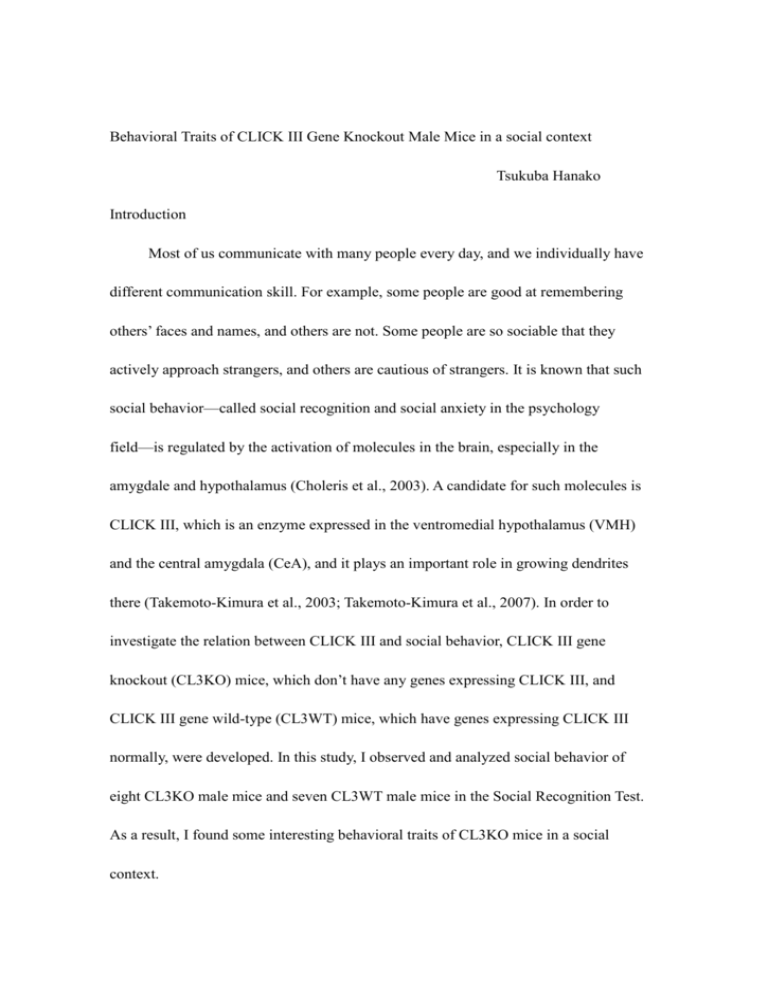behavioral_traits_CLICK_w_comments_2011.11
advertisement

Behavioral Traits of CLICK III Gene Knockout Male Mice in a social context Tsukuba Hanako Introduction Most of us communicate with many people every day, and we individually have different communication skill. For example, some people are good at remembering others’ faces and names, and others are not. Some people are so sociable that they actively approach strangers, and others are cautious of strangers. It is known that such social behavior—called social recognition and social anxiety in the psychology field—is regulated by the activation of molecules in the brain, especially in the amygdale and hypothalamus (Choleris et al., 2003). A candidate for such molecules is CLICK III, which is an enzyme expressed in the ventromedial hypothalamus (VMH) and the central amygdala (CeA), and it plays an important role in growing dendrites there (Takemoto-Kimura et al., 2003; Takemoto-Kimura et al., 2007). In order to investigate the relation between CLICK III and social behavior, CLICK III gene knockout (CL3KO) mice, which don’t have any genes expressing CLICK III, and CLICK III gene wild-type (CL3WT) mice, which have genes expressing CLICK III normally, were developed. In this study, I observed and analyzed social behavior of eight CL3KO male mice and seven CL3WT male mice in the Social Recognition Test. As a result, I found some interesting behavioral traits of CL3KO mice in a social context. Method of the Social Recognition Test Individual mice were tested four times (tests 1–4) in their home cage, into which a cylinder containing a stimulus mouse was introduced. The cylinder had 36 holes, each 4 mm in diameter drilled in the bottom. which allowed the passage of olfactory cues while preventing direct interaction between the experimental and the stimulus mouse. Each test lasted four minutes, and tests were repeated at 15-min intervals. In tests 1–3, the same stimulus mouse was used, whereas in test 4, a novel stimulus mouse was used. In all tests, social investigation (active sniffing of the holes) duration and latency, the number of stretched approaches considered as social anxiety-related behaviors, and total locomotion distance were measured. Results First, CL3KO mice could distinguish between a familiar stimulus and a strange stimulus as well as CL3WT mice. Both of them showed normally decreasing social investigation duration throughout tests 1–3 when presented with the same stimulus mouse. They showed a normal increase of social investigation duration in test 4 when presented with a novel stimulus mouse. In other words, they were habituated to the same stimulus presented repeatedly, and they were dishabituated to the novel stimulus. This result suggests CL3KO mice have normal ability in social recognition, by which they can determine whether they have seen someone or not. Second, CL3KO mice were more sociable than CL3WT mice. They showed significantly longer social investigation duration and shorter social investigation latency than CL3WT mice in test 1. This means CL3KO mice have a great interest in a social stimulus and/or they are careless. In addition, CL3KO mice showed less anxiety-related behavior than CL3WT mice. CL3WT mice were cautious of a stimulus mouse and they did an average of about four stretched approaches in test 1, whereas CL3KO mice did few stretched approaches. Stretched approaches represent a conflict between interest and fear. It is suggested CL3KO mice don’t have the conflict, and they are moved only by interest in a social stimulus. References Cited Choleris, E., Gustafsson, J., Korach, K., Muglia, L.,Pfaff, D., Ogawa, S. (2003). An estrogen-dependent four-gene micronet regulating social recognition: A study with oxytocin and estrogen receptor-alpha and –beta knockout mice. Proc Nat Acad Sci USA, 100, 6192-6197. Takemoto-Kimura, S., Terai, H., Takamoto, M., Ohmae, S., Kikumura, S., Segi, S., Arakawa, Y., Furuyashiki, T., Narumya, S. (2003). Molecular Cloning and Characterization of CLICK-Ⅲ/CaMKIγ, a Novel Membrane-anchored Neuronal Ca2+/Calumodulin-dependent Protein Kinase (CaMK). The Journal of Biological Chemistry. 278, 18597-18605. Takemoto-Kimura, S., Ageta-Ishihara, N., Nonaka, M., Adachi-Morishima, A., Mano, T., Okamura, M., Fujii, H., Fuse, T., Hoshino, M., Suzuki, S., Kojima, M., Mishina, M., Okuno, H., Bito, H. (2007). Regulation of Dendritogenesis via a Lipid-Raft-Associated Ca2+/Calmodulin-Dependent Protein Kinase CLICK-Ⅲ/CaMKIγ. Neuron, 54, 755-770.







